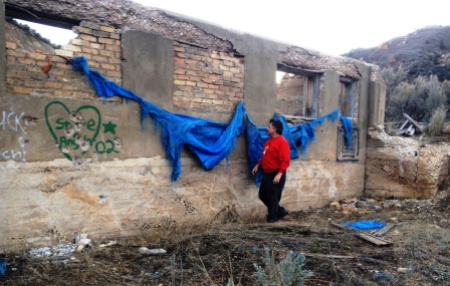I wasn’t trying/
to “say” anything. I was/
just trying to “do”.
Tag Archives: Kuhns
Creating Found Object Art: A Draped-Wall Recipe — Revolutionary Blogging Free Verse Poem
Blank Canvas

Location:
A grafittied and windowed
cement, brick and adobe ruined wall
in a ghost town
in Central Utah.
Ingredients:
A several foot long
orange and black
polyester rope.
Two 5-inch pieces
of bailing wire.
Several pieces of old blue tarp,
starting to dissolve,
twisted, torn
and actively ripping.
A used square red 4-holed brick.
A used broken yellow clay brick.
Two pieces,
one yellow,
one orange,
of baling twine
pulled off rotted hay bales.
Installation
Throw the rope through
the Eastern-most,
partially bricked-up
window,
Cask of Amontillado-like,
toward the snow-covered,
sunset pink mountain peaks
in the distance.
The black-orange coral-snake
now hangs over
the graffitied north wall
of the adobe and cement house ruins.
Take one end of
the largest piece
of blue tarp
and twist-tie it to the rope.
Unravel the frayed blue plastic
until you find the strongest
and longest
terminus
opposite the rope end.
Tie the open end
to another end of frayed blue tarp.
Repeat the process,
laying the tarp lengthwise
along the base of the cement/adobe wall,
until it reaches the far western wall.
Twist-tie two pieces of bailing twine
to the end of the frayed blue tarp piece.
Take the other end of twine
and run it
through a center hole of the red brick.
Tie them together.

Raise the red brick to sit on the edge
of the far West window.
The frayed blue tarp will rise.
Unfurl and untwist
pieces of blue tarp
so they are extended
as far as possible.
Final Adjustments
In the center,
raise a triangled piece
of frayed blue tarp
to the sill of the third window.
Place the yellow brick on the tarp,
holding it in place.
The blue tarp will now be draped
over the wall.
Push the red brick
through the western window,
so the tarp raises higher
and is taut.
In the center,
find a grommet
in the blue tarp.
Take a piece of baling wire
and twist it through the grommet,
leaving the wire’s end
extended.
Raise the blue tarp and grommet
as high as possible.
Insert the bailing wire
deep into a crack between the bricks
in the middle bricked-up window,
insuring it is tight.
Go to the other side
of the Eastern,
partially-bricked window,
and pull the rope
until the tarp
is completely raised
and taut.
Finished.
Is It Art? What Is?
Christo trucked in
fabric sheets
and ran a fence,
draping miles
of Nature’s perfect
California coastal
mountainside scenery.
They raised The Gates,
which stood
in Central Park,
stopping folks
wanting to bike
and play
on the lawn.
In 14 days,
the mono-colored
Tibetan Prayer-Flag-like
piece
won’t be taken down.
The fabric
and the ropes
and the walls
and the creators
won’t have grant money
given,
or books written about,
or Life Magazine photo essays
shot
extolling.
Yet who is to say that
groupings of found objects,
similarly hung
by unknown creatives
on the side of
a mud-slide destroyed
ruin
in a Utah railroad ghost town
once known as Thistle,
isn’t also art?
Return(ed) With Honor: Revolutionary Blogging Free Verse
The red sandstone lay,
slight dimpled drill hole,
square-cut right-angled block,
beneath an ancient cross-joist
floor timber.
I thought I could take it,
a memory of someone’s old home,
a house I’d often seen
before a geological disaster
mud-slid, then drowned it
and its town,
thistle down,
into near oblivion.
Utah’s Pompeii,
covered with mud
except for a few
cut-stone
structures.
This red sandstone rectangle,
90 degree
right angle cut
not found in nature:
No one would miss it.
The rough red
would create an awesome border
on my garden,
a new use for old stone.
But even as I hoisted it
and walked car-ward,
it seemed to say:
“Stay.”
Heading downhill,
I slipped on rain-soaked mud
and had to throw it as I fell
to avoid having it
crush my pelvis.
Sitting in the back
of my car,
it seems to whisper
“Take me home.”
I almost dropped it off
last night,
right after I nearly hit
a white-tailed deer
on State Route 89,
near where there jersey barrier
separates me
and the block
from the home
it has known
for a hundred years.
Do the stones
have souls?
Do the square-cut corners
and dimpled indentations
still hold memories
and longingly speak?
I do not know.
I do know
that it does not belong
with me,
in my garden.
So I willdid return it
with honor,
and will hopefully
not slip again.

Real Men Do Their Own Laundry: Revolutionary ImproVerse Haiku
If you let your mom/
do your laundry, she will shrink/
every shirt you own.
And Now, Apple, What? Romantic Email Free Verse Poem
Now, I’ve returned.
Now, we’ve again met.
It was nice seeing
her again.
Now what?
My enthusiasm is not
rampant.
My desire is not
intense,
unlike the past.
But I’m not ambiguous, either.
I’m calm,
waiting,
like sap within
an old apple tree’s roots
after a long winter.
It waits to be warmed
by spring sun’s rays.
To rise up
and flow out
and push the buds
into blossoms
that explode
inscentandcolorandbeauty
and eventually
bear sweet fruit.
Outside, pink-red
like her lips and skin.
Inside, light gold
like her hair,
moist like the sap
that is starting, now, to move.
With stem to twist
and ask,
at harvest,
“Now what?”
Pick, and taste,
and savor the sweetness
and nourishment
.
Or ignore
until the fruit
grows past
what it could have been
and falls,
unnoticed,
to the ground,
where it bruises,
and turns brown
and sour
and rots.
No Apologies To Stephen Hawking: Revolutionary ImproVerse Haiku
“While there’s life, there is hope.” STEPHEN HAWKING, People’s Daily Online, Jun. 14, 2006
Even when there is/
no life, there is life, and so/
there is always hope.


